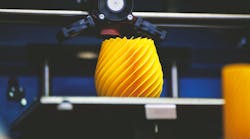As a manufacturer, you may find a lot of problems in the workplace have to do with missing or broken components. Replacing these components will take time and money, so being able to reproduce those parts on the factory floor can be a big help, even if just temporarily. One of the reasons 3D printing has become so popular is because of the help the invention lends to manufacturers.
However, 3D printing might not always be the best option. While it certainly sounds amazing on paper, there can be hidden drawbacks you may not see until you already own and use one. To be fair, 3D printers are pretty incredible machines, they just aren't as unique as you may think. Maybe there's something out there that's better for manufacturing.
3D printing and additive manufacturing — Additive Manufacturing (AM) is the process of three-dimension parts being made by creating one layer of material at a time according to the design dictated by a digital program (CAD) model. There are different technologies, but in general 3D printing and can be adapted to create things in a home, office, factory, or nearly anywhere. The terms 3D printing and AM are used interchangeably. In many manufacturing environments, the process is known as AM.
AM can be adapted for use with plastics, metals, composites or ceramics as materials, making options almost limitless — assuming you have the tools to print the appropriate parts. 3D printing is not as viable on the factory for this reason alone, which is being unable to meet demands quickly, cheaply, and in a better way than other possibilities. Some 3D printers can meet at least two of the expectations but finding all three would be difficult.
CNC manufacturing — Computer numerical control or CNC is subtractive manufacturing, meaning it removes material, whereas AM adds material. The CNC milling, turning, or grinding machine starts with a block of nearly any material and carefully removes all the unnecessary parts according to the precise dimensions dictated by the CAM/CAD program. NC and CNC technology has been available for decades, and sometimes it’s called traditional manufacturing because it has become so widely adopted.
Depending on the types of parts needed, trying to upgrade to a modern 3D printer may not be necessary or even better. Sometimes taking the proven route is best for all involved. As impressive as 3D printing is, there are limitations that potential adopters do not typically realize — limitations that may evolve into problems after the capital investment has been made.
Here are a few reasons why 3D printing might not be your best investment:
1. Limited materials — As stated, plastics, ceramics, composites and metals can be used in 3D printing. While these four bases cover a lot of different materials, it's still a very limited list. Some 3D printers are specialized enough to use glass or even gold but these are not commercialized systems. If you want to print things like that, you'll have to invest a lot more.
There are a lot of materials AM cannot use at all, like wood, which makes those sorts of specialized parts much more expensive for both the manufacturer and customer. If you're a manufacturer that relies on materials that are not usually available for 3D printing, perhaps you're considering substitution. Unfortunately, this may decrease the quality of the finished part more than you think simply because …
2. Reliance on plastic — The really inexpensive 3D printers use plastic because it's easy to heat, easy to mold and easy to cool. Even further shaping after the product is complete is easy to do. While you're switching from wood to metal, you might find it cheaper and easier to just switch from metal to plastic, and this is where a big change begins. Not only will the quality of the product be changed (reduced) significantly, but the environment gains nothing from this change either.
The machines often leave unused plastic in the print beds, and the most commonly used type of plastic, ABS, is not biodegradable. This has an environmental impact as that plastic waste ends up in landfills.
More than this, your process now is much more limited because since all you have to work with is plastic. The cycle just continues in that direction.
3. Consumes a lot of energy — Depending on how you use 3D printers, they may not save any operating costs because they consume a lot more power than may be expected. According to Loughborough University, in production of plastic parts 3D printers use anywhere from 50 to 100 times more energy than injection molding due to the requirements for melting plastics.
Furthermore, Environmentally Benign Manufacturing found that melting metals for AM uses 100 times more energy than CNC manufacturing. If you're producing parts in large volume, 3D printers simply use too much power. That's another reason why subtractive manufacturing is a more attractive option.
4. Pollution in the workplace — Because most 3D printers are literally melting plastic, they produce very harmful toxic emissions while in use. When in an enclosed space, such as a factory running a high-volume operation, these emissions can become dangerous, including airborne carcinogenic particles in the workplace atmosphere.
A 2013 study published by the Illinois Institute of Technology concluded 3D desktop printers emit a large volume of hazardous compounds during printing. PLA plastics, which are biodegradable, release up to 20 billion ultrafine harmful particles per minute. The more commonly used ABS plastics release up to 200 billion particles per minute.
Your other options
AM or 3D printing is still impressive, but manufacturers will learn that it’s worth the time to shop for best for method to solve a particular problem. Subtractive manufacturing is the traditional option not just because it's been around for decades but because it has been proven to work well. Sometimes, the old tricks are the best tricks, and CNC machining might be the best method available without the unanticipated risks.
There is a place for 3D printing in manufacturing, especially for small, temporary or emergency components. However, for large operations making the same piece over and over, CNC remains the best investment, for value and health.
Kayla Matthews writes about the IoT, IIoT, automation and smart technologies for publications like InformationWeek, Manufacturing.net, Robotiq others. To read more from Kayla, follow her personal tech blog, Productivity Bytes.








